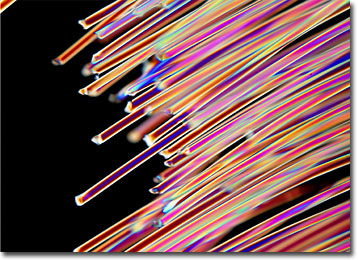Polarized Light Microscopy Digital Image Gallery
Tencel Fibers
Tencel is the trademark name of a relatively new lyocell fiber created by Courtaulds PLC. Due to the fiber’s natural origin and an innovative production process that utilizes a non-toxic solvent, it is often marketed as an environmentally friendly material.

View a second image of Tencel Fibers
Though the fiber is manmade, Tencel is derived from the wood pulp of trees grown in managed forests and is completely biodegradable. The production of the fiber involves a “closed loop” spinning process, in which the non-toxic solvent is continuously recycled and energy and water are conserved. Twisted or spun into yarns, Tencel can easily be utilized to knit or weave fabrics that are strong, absorbent, and comfortable. Tencel fabrics are also especially recognized for the fluidity of their drape and their ready acceptance of dyes. Many Tencel fabrics are machine washable, as well as shrinkage and wrinkle resistant.
There are currently two different types of Tencel branded by Courtaulds PLC. Standard Tencel is differentiated from Tencel A100 by its fibrillation, which generates the material’s luxurious feel. Standard Tencel is chiefly utilized in items such as garment-processed denim, soft separates, and fabrics for customized attire. Tencel A100 is aesthetically different from the standard type, but provides similar high-quality performance and its processing produces less waste products and requires less dyestuff. The fiber, which is also more-cost effective to produce than the standard variety, is more widely utilized as well, commonly being exploited for use in activewear, sportswear, knits, intimate apparel, and home furnishing fabrics.
